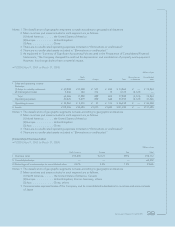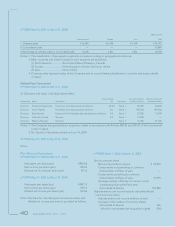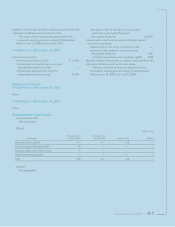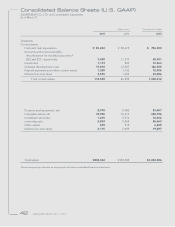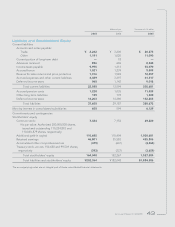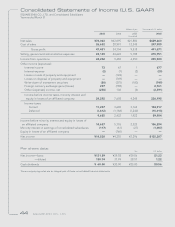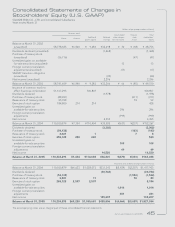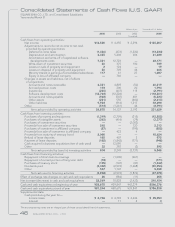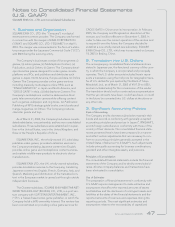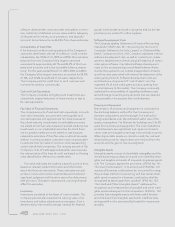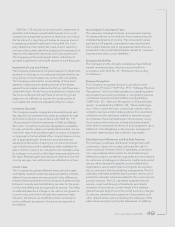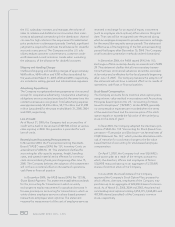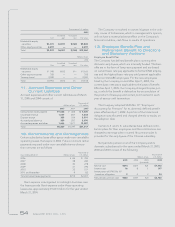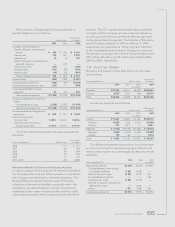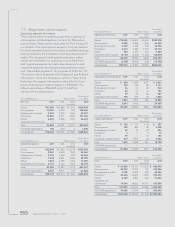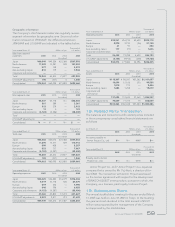Square Enix 2005 Annual Report Download - page 51
Download and view the complete annual report
Please find page 51 of the 2005 Square Enix annual report below. You can navigate through the pages in the report by either clicking on the pages listed below, or by using the keyword search tool below to find specific information within the annual report.
49
Annual Report 2005
SFAS No. 142 requires an annual test for impairment of
goodwill, and between annual tests if events occur or cir-
cumstances change that would more likely than not reduce
the fair value of a reporting unit below its carrying amount.
In assessing potential impairment of goodwill, the Com-
pany determines the implied fair value of each reporting
unit using discounted cash flow analysis and compares such
values to the respective reporting unit’s carrying amount.
The Company performs its annual test for indication of
goodwill impairment in the fourth quarter of each fiscal year.
Impairment of Long-Lived Assets
The Company evaluates its long-lived assets for impairment
as events or changes in circumstances indicate that the car-
rying amount of such assets may not be fully recoverable.
The Company evaluates the recoverability of long-lived
assets by measuring the carrying amount of the assets
against the estimated undiscounted future cash flows asso-
ciated with them. At the time such evaluations indicate that
the future undiscounted cash flows of certain long-lived
assets are not sufficient to recover the carrying value of
such assets, the assets are adjusted to their fair values
Investment Securities
The Company invests in equity securities and bonds, and
has classified its investment securities as available-for-sale
and held-to-maturity, in accordance with SFAS No. 115
“
Accounting for Certain Investments in Debt and Equity
Securities
.” Investment securities designated as available-
for-sale, whose fair values are readily determinable, are car-
ried at fair value with unrealized gains or losses included as
a component of accumulated other comprehensive income,
net of applicable taxes. Investment securities that are
expected to be held-to-maturity are carried at amortized
cost. Individual securities classified as either available-for-
sale or held-to-maturity are reduced to net realizable value
by a charge to income for other than temporary declines in
fair value. Realized gains and losses are determined on the
moving average cost method and are reflected in income.
Income Taxes
The Company recognizes deferred taxes using the asset
and liability method. Under the asset and liability method,
deferred income taxes are recognized for the differences
between financial statement and tax bases of assets and lia-
bilities at currently enacted statutory tax rates for the years
in which the differences are expected to reverse. The effect
on deferred taxes for a change in tax rates is recognized in
income in the period that includes the enactment date.
Valuation allowances are established when necessary to
reduce deferred tax assets to the amounts expected to
be realized.
Accounting for Consumption Taxes
The Japanese consumption taxes received and consump-
tion taxes paid are not included in the accompanying con-
solidated statements of income. The consumption taxes
paid are set off against consumption taxes received and
the resultant balance due to Japanese tax authorities are
presented in the consolidated balance sheets as “accrued
expenses and other current liabilities.”
Employee Benefit Plan
The Company and its domestic subsidiaries have defined
benefit retirement plans, which are accounted for in
accordance with SFAS No. 87 “
Employers’ Accounting
for Pensions.
”
Revenue Recognition
The Company recognizes revenue in accordance with
Statement of Position (“SOP”) No. 97-2, “
Software Revenue
Recognition,
” which provides guidance on applying gener-
ally accepted accounting principles in recognizing revenue
on software transactions and Staff Accounting Bulletin
(“SAB”) No. 101, “
Revenue Recognition in Financial State-
ments,
” as amended by SAB No. 104, “
Revenue Recogni-
tion,
” which outline the basic criteria that must be met to
recognize revenue and provides guidance for presentation
of revenue and for disclosure related to revenue recogni-
tion policies in financial statements. The Company recog-
nizes revenue when the price is fixed and determinable,
when there is persuasive evidence of an arrangement, upon
fulfillment of its obligations under any such arrangement
and when determination that collection is probable.
Sales Returns and Allowances and Bad Debt Reserves
The Company’s software distribution arrangements with
customers in Japan do not give customers the right to
return products; however, the U.S. subsidiary, at its discre-
tion, may accept product returns for stock balancing or
defective products, sometimes negotiates accommodations
to customers, including price discounts, credits and product
returns, when demand for specific products falls below
expectations, and accepts returns and grants price protec-
tion in connection with its publishing arrangements. The U.S.
subsidiary estimates potential future product returns, price
protection and sales incentives related to the current period
product revenue. The U.S. subsidiary analyzes historical
returns, current sell-through of distributor and retailer
inventory of its products, current trends in the software
games business segment and the overall economy, changes
in customer demand and acceptance of its products and
other related factors when evaluating the adequacy of the
sales returns and price protection allowances. In addition,


